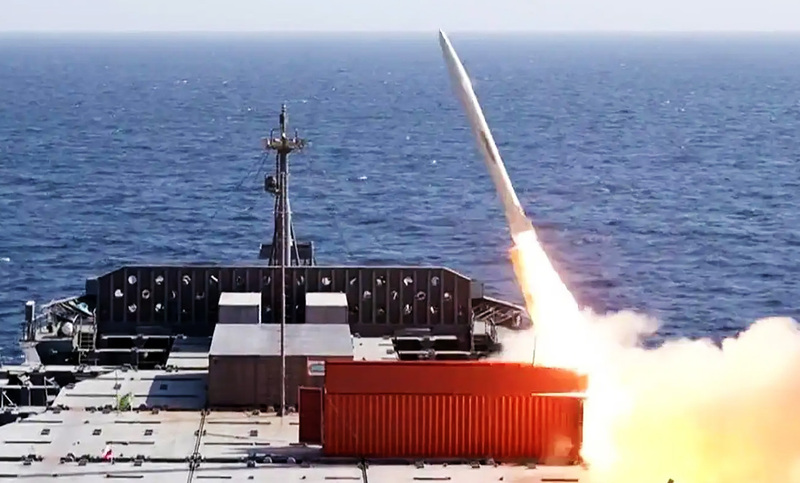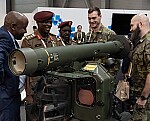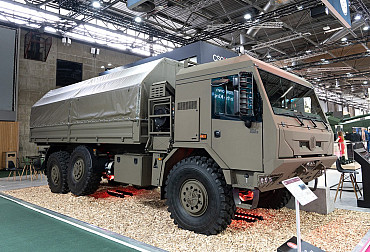Iran just tested a ship-based missile fired from a shipping container
According to the latest report, Iran just tested a missile launched from a civilian shipping container. This, together with the fact that Russia uses similar technology, could have major implications for international security and stability in the context of rising China.
Iran just released a video footage showing missile launch from a civilian shipping container. The footage reportedly captures the launch of Dezful medium range ballistic missile with a maximum range of approximately 1000 km. According to Iranian media, the Dezful missile could travel at a speed of Mach 7 and thus be considered a hypersonic missile. On the other hand, there is no evidence to support this claim. Reportedly, the Dezful missile is an upgraded variant of the surface-to-surface Zolfaghar missile with a maximum range of approximately 700 km. Apart from the surface-to-surface variant, the Iranian Revolutionary Guard Corps (IRGC) also deploys an anti-ship variant of this ballistic missile. However, it is not known whether the Ansar Allah movement used those missiles against civilian ships during its campaign in recent months.

Launched from the 40-foot civilian cargo container, this missile gives IRGC unprecedented capability in terms of deception and surprise strikes. IRGC could simply send ships that look like civilian cargo ships to sea and launch those missiles from civilian ships.
There is also another international state actor that utilizes similar technology – Russia. Russian defense companies develop a version of the well-known Kalibr cruise missile that could be launched from a 40-foot container similar to the container used during the Iranian missile test. „Club-K “– the code name for the missile launcher – could also launch the Kh-35 anti-ship missile known from the Russian coastal defense missile system Bal. Club-K missile system war introduced to the public during a defense expo in South Korea in 2017. The US delegation immediately strongly protested due to the the high complexity of the system and the fact that missiles could be launched not only from civilian cargo ships but also from also from freight vehicles and railway platforms. The range of this missile depends on the variant, but it is believed to have a range between 300 and 1200 km. Although the Russian army seems not to deploy these novel missile systems, it potentially gives the Russian army an upper hand against Ukraine and potentially NATO.
In the case of Ukraine, Russia could exploit the fact that the missile could be launched from civilian cargo means and swap ships and pure military target for civilian ones. This allows Russia to potentially confuse NATO intelligence gathering apparatus over the Black Sea and thus make it impossible for Ukraine to strike missile launchers in the Black Sea region. This could also be applied to the potential conflict with NATO when the Russian army could launch Kalibr-like missiles from railway platforms and freight vehicles.
Although there is no evidence of cooperation between Russia and Iran on this matter, one cannot rule out the event's possibility. According to the latest reports, Iran is set to receive Su-35 fighter jets from Russia in exchange from one-way attack drones Shahed-131/136 used against Ukraine and possibly ballistic missile from the Fateh and Zolfaghar family. Thus, one cannot rule out the possibility of cooperation in the missile sector and transfer of at least know-how of the Club-K missile system. This development would be highly concerning not only due to Iranian connection to the Ansar Allah movement and Russian intentional against NATO in Europe, but due to Chinese behavior in international relations and willingness to use force against Taiwan and other international players.
China could exploit this missile system in the connection of the Chinese civil-military fusion program. The People’s Liberation Army uses many civilian and dual-use technologies in the military. For example, the PLA lacks cross-strait transport capacity for successful invasion of Taiwan, and thus exploits the so-called Roll-on/Roll-off civilian ships to transport its forces. Thus, the missile system capable of launching both land-attack and anti-ship cruise missiles could be a next step in the Chinese civil-military fusion program. Russian technology and possible Iranian real combat experience could teach Chinese operators valuable lessons on how to use this kind of system during actual combat against Taiwanese or US armed forces.










